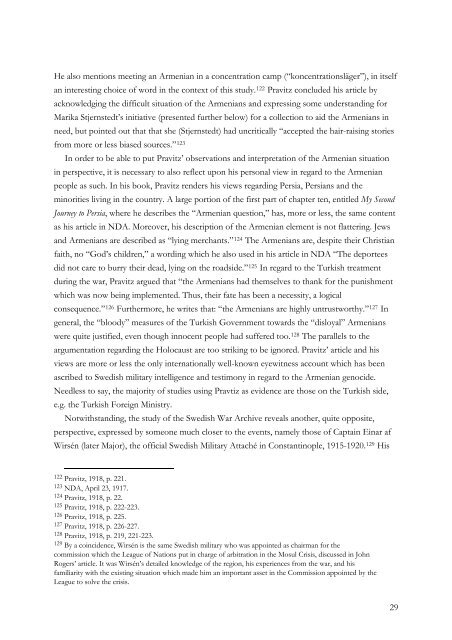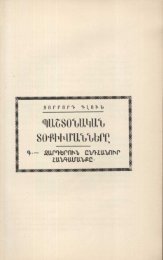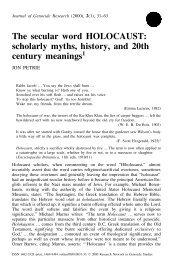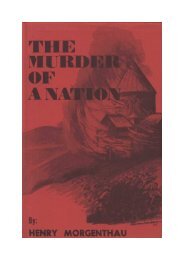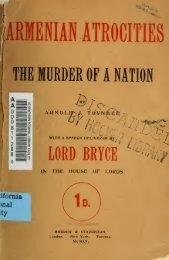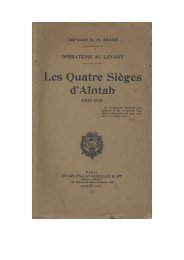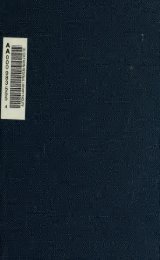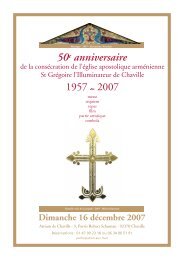and not all the sources are first hand information. The second is the experiences of Dr. MartinNiepage, Higher Grade Teacher in the German Technical School at Aleppo. This study hasconcentrated mainly on the information which is regarded to be of a more reliable nature,excluding most of the information attained by hearsay. Their content gives an interesting insightinto the events, both as first hand testimonies as well as analysis of how the massacres wereunderstood. In addition there are s<strong>om</strong>e other non-Swedish witness accounts, translated andpublished in Sweden, which are included in this study.The Swedish missionary reports, letters and pamphlets were yet another mean to affect thepublic opinion, mainly to initiate and persuade the civilian Swedes to contribute to humanitarianaids and collections for the benefit of the victims and survivors of the Armenian massacres. But,they could also indicate the knowledge of the Swedish Church and its choice of action in regardto the massacres as well as actions taken by the missionaries in Ott<strong>om</strong>an Armenia. The roleplayed by the missionaries will also be used to see whether they should be seen as bystanders ornot.1.4.4 The Swedish MilitaryMoving further up the “reliability scale” of the reports in regard to the events in Ott<strong>om</strong>an Turkey,and their impact on Swedish State knowledge and basis of decision making, are the reports ofSwedish military personnel.The most frequently cited Swedish military testimony in regard to the Armenian genocide isthat of Major Gustav Hjalmar Pravitz, published in Nya Dagligt Allehanda, mentioned below in thechronological data. Pravitz was actually stationed in Persia and not in the Ott<strong>om</strong>an Empire. Hewas a member of the Swedish military mission invited to improve Persia’s gendarmerie and policeoperations. 119 In 1918, Pravitz published his memoirs, Från Persien i stiltje och storm (“Fr<strong>om</strong> Persiain Calm and Storm”). Recalling this very same content a year earlier, Pravitz makes an interestingassertion, clai<strong>min</strong>g it is historically proven, that “…swift passing, even though bloody eruptionsof despotism, such as the Armenian massacres, are more tolerable for a people than a continuous,but milder oppression, for which no end can be seen.” 120 Pravitz admitted that he had seen deadbodies and dying people begging for a piece of bread, but, with the exception of one case, he didnot see the asserted violence used against the Armenian “emigrants”:I have seen dying and dead along the roads — but among hundreds of thousands there must, ofcourse, occur casualties. I have seen children’s corpses, shredded to pieces by jackals, and pitifulindividuals stretch their bony arms with piercing screams of “ekmek” (bread).But I have never seen direct Turkish assaults against the ones hit by destiny. A singletime I saw a Turkish gendarme in passing hit a couple of slow moving people with his whip; butsimilar things have happened to me in Russia, without me c<strong>om</strong>plaining, not then, nor later. 121119 Pravitz, 1918.120 Pravitz, 1918, p. 222.121 NDA, April 23, 1917.28
He also mentions meeting an Armenian in a concentration camp (“koncentrationsläger”), in itselfan interesting choice of word in the context of this study. 122 Pravitz concluded his article byacknowledging the difficult situation of the Armenians and expressing s<strong>om</strong>e understanding forMarika Stjernstedt’s initiative (presented further below) for a collection to aid the Armenians inneed, but pointed out that that she (Stjernstedt) had uncritically “accepted the hair-raising storiesfr<strong>om</strong> more or less biased sources.” 123In order to be able to put Pravitz’ observations and interpretation of the Armenian situationin perspective, it is necessary to also reflect upon his personal view in regard to the Armenianpeople as such. In his book, Pravitz renders his views regarding Persia, Persians and the<strong>min</strong>orities living in the country. A large portion of the first part of chapter ten, entitled My SecondJourney to Persia, where he describes the “Armenian question,” has, more or less, the same contentas his article in NDA. Moreover, his description of the Armenian element is not flattering. Jewsand Armenians are described as “lying merchants.” 124 The Armenians are, despite their Christianfaith, no “God’s children,” a wording which he also used in his article in NDA “The deporteesdid not care to burry their dead, lying on the roadside.” 125 In regard to the Turkish treatmentduring the war, Pravitz argued that “the Armenians had themselves to thank for the punishmentwhich was now being implemented. Thus, their fate has been a necessity, a logicalconsequence.” 126 Furthermore, he writes that: “the Armenians are highly untrustworthy.” 127 Ingeneral, the “bloody” measures of the Turkish Government towards the “disloyal” Armenianswere quite justified, even though innocent people had suffered too. 128 The parallels to theargumentation regarding the Holocaust are too striking to be ignored. Pravitz’ article and hisviews are more or less the only internationally well-known eyewitness account which has beenascribed to Swedish military intelligence and testimony in regard to the Armenian genocide.Needless to say, the majority of studies using Pravtiz as evidence are those on the Turkish side,e.g. the Turkish Foreign Ministry.Notwithstanding, the study of the Swedish War Archive reveals another, quite opposite,perspective, expressed by s<strong>om</strong>eone much closer to the events, namely those of Captain Einar afWirsén (later Major), the official Swedish Military Attaché in Constantinople, 1915-1920. 129 His122 Pravitz, 1918, p. 221.123 NDA, April 23, 1917.124 Pravitz, 1918, p. 22.125 Pravitz, 1918, p. 222-223.126 Pravitz, 1918, p. 225.127 Pravitz, 1918, p. 226-227.128 Pravitz, 1918, p. 219, 221-223.129 By a coincidence, Wirsén is the same Swedish military who was appointed as chairman for thec<strong>om</strong>mission which the League of Nations put in charge of arbitration in the Mosul Crisis, discussed in JohnRogers’ article. It was Wirsén’s detailed knowledge of the region, his experiences fr<strong>om</strong> the war, and hisfamiliarity with the existing situation which made him an important asset in the C<strong>om</strong>mission appointed by theLeague to solve the crisis.29
- Page 3 and 4: 1 Introduction.....................
- Page 5 and 6: War, rather confirm the version of
- Page 7 and 8: 1.2 Previous ResearchWhen discussin
- Page 9 and 10: Military Attaché and the missionar
- Page 11 and 12: situation: “It is a crime when Te
- Page 13 and 14: in the following investigation, whi
- Page 15 and 16: killed. The slaughterer slaughtered
- Page 17 and 18: interests. Despite his famous “14
- Page 19 and 20: morality, balance of power, or the
- Page 21 and 22: 4. International organisations (e.g
- Page 23 and 24: warring parties. 104 This observati
- Page 25 and 26: Concerning the protocols of the Swe
- Page 27: present in Turkey. These documents
- Page 31 and 32: the annihilation. General von Losso
- Page 33 and 34: 1.5 BackgroundIn order to understan
- Page 35 and 36: 1914, when two inspector-generals f
- Page 37 and 38: to Islam or were sold as slaves to
- Page 39 and 40: 2 Empirical AnalysisThe empirical r
- Page 41 and 42: It does not seem to be the Turkish
- Page 43 and 44: The Turks claim that, at the Russia
- Page 45 and 46: The Armenian population has equippe
- Page 47 and 48: 1917 was the revival year for the A
- Page 49 and 50: Even if the communication between t
- Page 51 and 52: implemented against the Armenian na
- Page 53 and 54: Anckarsvärd continued claiming tha
- Page 55 and 56: Germany is blamed for its accessory
- Page 57 and 58: Here Wirsén took the liberty to co
- Page 59 and 60: On February 19, news of new Armenia
- Page 61 and 62: estricted to the fields of intrigue
- Page 63 and 64: generous offer of President Wilson
- Page 65 and 66: Lange gave a detailed description o
- Page 67 and 68: skin was totally scorched. Another
- Page 69 and 70: which her recurrently emphasised th
- Page 71 and 72: The sooner calls referring to the A
- Page 73 and 74: Despite these facts, Armenia was th
- Page 75 and 76: Svenska Riksarkivet [Swedish Nation
- Page 77 and 78: Bakhtiari, Kalla det vad fan du vil
- Page 79 and 80:
Chan, Steve and Drury, Cooper A., S
- Page 81 and 82:
Moranian, Suzanne Elizabeth, Bearin


